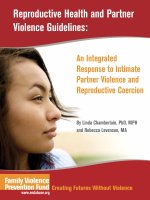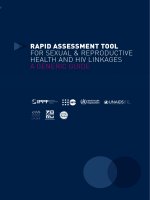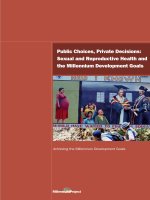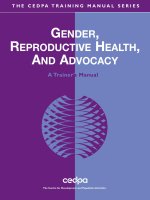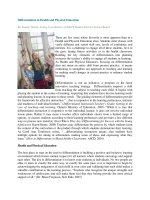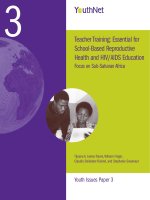Standards for Curriculum-Based Reproductive Health and HIV Education Programs pdf
Bạn đang xem bản rút gọn của tài liệu. Xem và tải ngay bản đầy đủ của tài liệu tại đây (223.53 KB, 65 trang )
Judy Senderowitz
and Douglas Kirby
Standards for
Curriculum-Based
Reproductive
Health and HIV
Education Programs
Standards for
Curriculum-Based
Reproductive
Health and HIV
Education Programs
YouthNet is a five-year program funded by the U.S. Agency
for International Development (USAID) to improve reproductive
health and prevent HIV among young people. The YouthNet team
is led by Family Health International (FHI) and includes CARE
USA and RTI International. This publication is funded through
the USAID Cooperative Agreement with FHI for YouthNet,
No. GPH-A-00-01-00013-00. The information contained in the
publication does not necessarily reflect FHI or USAID policies.
© 2006 by Family Health International
ISBN No. 1-933702-02-8
Family Health International/YouthNet
2101 Wilson Boulevard, Suite 700
Arlington, VA 22201 USA
703-516-9779 (telephone)
703-516-9781 (fax)
www.fhi.org/youthnet
Table of Contents
Acknowledgments 5
1. Introduction and Overview 7
Development of the Standards 8
How to Use This Manual 11
Beyond the Standards: Major Issues in
RH/HIV Education Programming 12
2. Checklist of Standards 15
3. Standards in Practice 21
A. Curriculum Development and Adaptation 21
B. Curriculum Content and Approach 28
C. Curriculum Implementation 38
Annexes
Annex 1. Meeting Agenda, New Evidence on
Curriculum-Based Reproductive Health
and HIV Education for Youth 47
Annex 2. Participants at Technical Consultation Meeting 49
Annex 3. Characteristics of Effective
Curriculum-Based Programs 50
Annex 4. Annotated Resources 52
5
Acknowledgments
This document is a result of two sources of data and information:
1) research commissioned by Family Health International
(FHI)/YouthNet on the impact and quality of sex and HIV education
curricula for youth; and 2) discussions about field experiences
in using such curricula in developing countries, held at a two-day
meeting in Washington, DC, January 9-10, 2006 (see Annexes
1 and 2).
The research was published in a YouthNet working paper
by Dr. Douglas Kirby and colleagues,
Impact of Sex and
HIV Education Programs on Sexual Behaviors of Youth in
Developing and Developed Countries
, which is available at:
/>WorkingPapers.htm
(click on Working Paper No. 2). The research
team reviewed published evaluations of projects using reproductive
health or HIV curricula and included in its findings a set of 17
characteristics of effective curricula (see Annex 3).
The two-day meeting in Washington was designed to present the
findings of this review and to add information to the discussions
based on first-hand experiences in implementing curriculum-
based programs in developing countries. The first day, which was
open to the public, included primarily presentations, with some
questions and general discussion. The second day was an expert
consultation, with invited participants, who are listed in Appendix
2. The purpose of the expert consultation was to discuss in-depth
the Kirby research and presentations from the first meeting, focusing
on the 17 characteristics of effective curricula. The discussions
at the expert meeting served as the basis for developing the
standards presented in this manual. The research and meetings
are discussed further in Section I.
Judith Senderowitz wrote this manual based on the Kirby research,
discussions at the expert consultation meeting, input from
participants at the expert meeting, and her own knowledge and
background in the field. As a consultant in the youth reproductive
health and HIV field, Senderowitz has worked widely on strategic
6
planning and program implementation and has written hundreds
of evaluations, overview papers, and expert documents for
Advocates for Youth, the World Bank, World Health Organization,
the United Nations Population Fund, U.S. Agency for International
Development, Pathfinder International, and others.
Dr. Douglas Kirby of ETR Associates has studied sex and HIV
education curricula for youth for more than 25 years and
has produced a series of seminal reports and publications on
the topic, including
Emerging Answers
for the U.S. National
Campaign to Prevent Teen Pregnancy and the 2005 report for
FHI/YouthNet. He has co-authored research on the
Reducing
the Risk, Safer Choices
, and
Draw the Line
curricula, all of
which significantly reduced unprotected sex, either by delaying
sex, increasing condom use, or increasing contraceptive use.
Hally Mahler, who managed behavior change communication
projects at YouthNet, coordinated the meetings and the develop-
ment of this report. Others at FHI/YouthNet also assisted: Aliza
Pressman helped gather the examples presented in this report;
Cindy Waszak Geary coordinated the Kirby research paper;
Bill Finger coordinated editing and production of this report;
Chris Parker was copyeditor; Karen Dickerson assisted with design
and production. Thanks to the following people who reviewed
all or parts of this report prior to publication: Mahua Mandal and
Shanti Conly at the U.S. Agency for International Development;
JoAnn Lewis, Tonya Nyagiro, and Ed Scholl of FHI; and meeting
participants. Design is by Hopkins Design Group.
Introduction and Overview 7
Introduction and Overview
1
Worldwide, more than 1.5 billion young people are in the tran-
sitional years, ages 10 to 24. The knowledge they acquire, the
values and attitudes they develop, and the skills they learn will
have enormous effects on their future well-being – and also that
of their societies. Most of these young people live in developing
countries, where their reproductive health is vulnerable, especially
for girls and young women. Rates of unintended pregnancy
and sexually transmitted infections (STIs) remain high, and HIV
has become the leading cause of death for young people in some
areas, such as sub-Saharan Africa.
In order for young people to make good decisions about sexual
and reproductive health (RH) matters, they need good information,
values and attitudes consistent with health goals, skills to behave
consistently with their knowledge and values, and access to quality
health services. Curriculum-based education can contribute to
providing what young people need in a structured format, with
flexible approaches that can be implemented in a variety of
settings. With these features, curriculum-based approaches
constitute an important strategy in addressing HIV/AIDS and
unintended pregnancy. Program evaluations and overview studies
have found that curriculum-based RH/HIV education can be
effective in widely differing geographic areas, various cultural
settings, and among youth of different income levels and both
sexes.*
Curriculum-based education is defined in this document as an
organized set of activities or exercises ordered in a developmental
fashion and designed to enable its target audience to obtain
specific knowledge, skills, and/or experiences. Curriculum-based
programs can be implemented in schools, community agencies,
health facilities, and other settings where young people can
assemble regularly.
* Kirby D, Laris BA, Rolleri L.
Impact of Sex and HIV Education Programs on Sexual Behaviors
of Youth in Developing and Developed Countries.
Research Triangle Park, NC: Family Health
International, 2005.
8
Standards for Curriculum-Based Reproductive Health and HIV Education Programs
Given the extensive use of curriculum-based RH/HIV programs,
a set of standards can help assess the quality of existing curricula,
select or adapt existing curricula, or develop new curricula.
Standards can also assist programs in implementing curricula.
Some of the key advantages that standards can provide include:
■ A compendium of research-tested and experience-based
standards of effective programs. The standards identified
in this document are based on research into characteristics
of effective programs coupled with field experience of
practitioners and managers (see “Development of the
Standards,” below).
■ Guidance on curriculum selection, adaptation, or design.
Standards form a good basis for selecting, adapting, or
developing a curriculum because they have met the tests of
feasibility, practicality, and effectiveness.
■ A framework for assessment and evaluation. Managers can
use the standards to maintain and upgrade quality of imple-
mentation, including their use in more formal evaluations,
which can indicate progress made according to various areas
and characteristics. Managers can also use the standards
for intermediate assessments, mid-course corrections, and
annual reviews.
■ A means to publicize program progress and foster support.
Using the standards to show where the program stands,
or how much it has improved, can help demonstrate the
program’s successes to stakeholders, the public, and donors.
Development of the Standards
These standards are based on two sources of information:
1) research commissioned by FHI/YouthNet, conducted by Dr.
Douglas Kirby and his colleagues at ETR Associates, and reported
in the YouthNet working paper,
Impact of Sex and HIV Education
Programs on Sexual Behaviors of Youth in Developing and
Developed Countries
; and 2) discussions about field experiences
in using such curriculum in developing countries, held at a
two-day meeting in Washington, DC, January 9-10, 2006.
Introduction and Overview 9
The research study was designed to: 1) determine the effects (if
any) of curriculum-based programs on sexual and RH knowledge,
attitudes, and behavior; and 2) identify the common character-
istics of the curricula shown to be effective in changing sexual
risk behaviors.
The Kirby team reviewed evaluations of curriculum-based
programs (see box) and established criteria for the analysis of
specific information obtained. This enabled the review team
to determine the effectiveness of the curriculum-based programs
across culture, settings, and age, and then to identify the
common characteristics of the curricula found to be effective.
(See the working paper for more details on methodology.)
The review noted some limitations, including lack of details in
some evaluations, especially on implementation of the curriculum.
Also, some evaluations had weak evidence of impact, which
meant that a clear relationship between effectiveness and
characteristics was difficult to demonstrate. The researchers
developed a list of 17 characteristics of effective curriculum-based
The Kirby team identified 83 evaluation studies for the review,
which met these criteria:
▼ Programs had to be curriculum-based, delivered to youth
in group situations, and target youth ages 9 to 24.
▼ Evaluations of the programs were completed or published
after 1990.
▼ Research methods had to consist of reasonably strong
experimental or quasi-experimental designs with both
intervention and comparison groups and both pretest and
post-test data collection, with sample sizes of at least 100.
▼ Impacts had to be measured for at least three months on
rapidly changing behaviors (such as frequency of sex, number
of sexual partners, use of condoms or contraception, and
sexual risk-taking) and for at least six months for those
behaviors that change less rapidly (such as initiation of sex,
pregnancy and birth rates, and STI rates).
Selection of Evaluation Studies
10
Standards for Curriculum-Based Reproductive Health and HIV Education Programs
programs as a “best approximation” of what is needed to achieve
effectiveness in these programs (see Annex 3). For details
on these characteristics, see the YouthNet working paper at:
/>ResearchWorkingPapers.htm
(click on Working Paper No. 2).
Field experiences in implementing curriculum-based programs
were a central part of a two-day workshop convened by YouthNet,
held in Washington, DC, January 9-10, 2006. The first day was
open to the public and included a summary of the ETR/YouthNet
study and other recent studies of curriculum-based programs
in developing countries. In addition, presentations focused on
implementation issues in Kenya and Jamaica, the planning
process for multiple countries by UNICEF, and other perspectives
(see Annex 1).
The second day was an expert consultation, with invited partic-
ipants, who are listed in Annex 2. This consultation sought
to provide context to the characteristics of effective curricula
identified in the research, consider tips and lessons learned that
could help translate the characteristics into workable standards,
and suggest additional experience-based issues that should be
considered in developing standards.
Participants at the consultation included program managers
and implementers from developing countries, program strategy
and review specialists, researchers, educators (including peer
educators), curriculum development experts, leaders in the
reproductive health and HIV education fields, and donors. The
meeting provided an opportunity for researchers and practitioners
to merge their areas of expertise and move from research findings
to formulating practical guidance for programming.
The 24 standards presented here are based on the characteristics
from the research and the discussions from experts on field
implementation. Twenty of the standards are adapted from the
17 characteristics; four of the standards emerged from the techni-
cal meeting. Along with the standards are tips to help improve
the attainment of the standards and program examples to illustrate
how standards can be implemented.
Introduction and Overview 11
How to Use This Manual
This manual can be used by program designers, curriculum devel-
opers and adapters, educators, managers, evaluators, and others
to assess the quality of their existing or proposed curriculum and
implementation – either at a single point in time or at intervals to
look at changes over time. Trainers, supervisors, and educators can
use these standards as a basic reference tool to learn more about
what experts consider state-of-the-art programming.
Before using an existing curriculum, program managers should
review it carefully to be sure that it is appropriate for their cultural
setting, age of youth, and other factors. If a curriculum is being
designed specifically for a program site, these standards can
increase the likelihood of positive outcomes. If an existing
curriculum is being selected or adapted for implementation,
these standards can help assess the likely effectiveness of such
a curriculum, and provide guidance for adding and revising
elements for a particular population, culture, and setting. These
standards can also help assess and improve existing programs.
The manual is designed to be flexible in its application. Section
II provides a chart of the 24 standards, with brief descriptions.
This chart can be used separately or posted for easy reference.
The standards are divided into three sections:
A. Curriculum Development and Adaptation
B. Curriculum Content and Approach
C. Curriculum Implementation
In general, the first two groups of standards – on curriculum
development and adaptation and on curriculum content and
approach – are directed at those who develop, write, and
adapt curricula. The standards on curriculum implementation
in the third group are more likely to involve managers who have
responsibility for implementing the curriculum.
Section III repeats the basic information from the chart of standards
and adds tips for ensuring that the standards are met. This section
also provides examples and lessons learned from experience in
using RH/HIV education curricula.
12
Standards for Curriculum-Based Reproductive Health and HIV Education Programs
These standards describe high-quality program features, but they
may not all be equally relevant in a particular setting or culture.
For example, existing laws or policies could make some of the
standards difficult or impossible to meet. Program managers may
need to alter them for a particular program setting. The reviewers
of a curriculum and these standards should include the managers,
supervisors, trainers, and educators, and possibly stakeholders
such as government representatives, program partners, and youth
themselves.
The resources in Annex 4 may also help in developing or adapting
curricula and in developing reproductive health and HIV
education programs. They include background materials, tools,
research, curricula, and Web sites.
Beyond the Standards: Major Issues in RH/HIV
Education Programming
This manual provides solid evidence for the elements of a cur-
riculum and how these elements should be delivered. However,
many concerns precede the development and implementation
of a curriculum, such as establishing a conducive policy environ-
ment. Even though some important issues need to be addressed
post-implementation, such as scaling up an effective program,
such major issues need to be considered
before
beginning to use
the standards. Whether or not these issues are – or will be –
important to a program, they should at least be considered in the
earliest planning stages. Below is a summary of these issues.
■ Foster a supportive policy environment. The legal and policy
environment must be supportive enough that a selected
curriculum can be implemented without serious barriers. If
there are laws or policies that would preclude such effective
implementation, advocacy actions may be needed to address
issues that can make the environment more supportive.
■ Develop support of community stakeholders and government.
The community needs to be informed, accepting, and sup-
portive – to a minimal extent, at least – in order to assist with
changing the policy environment and to provide advocacy
for the continuing program. Identifying key stakeholders is
Introduction and Overview 13
important. These include local government leaders, education
and health authorities, faith-based leaders, civil society
leaders, parents, and youth themselves. If the program is
intended to be in the formal education or another government
sector (even if that will occur in the future), involving
government leaders at the early stage of program planning
is essential.
■ Build on a foundation of existing structures and assets.
Programs can always get underway more quickly and have
greater longevity if they are established as part of existing
structures and efforts, such as part of functioning organizations,
integrated into government programs, or implemented as
partnerships with ongoing activities.
■ Position the process within a larger program. Curriculum-
based programs in the schools are part of the larger educational
structure and system. They require approvals, review and
adoption, teacher credentialing, grade level sequencing,
testing, and other issues to comply with policy and practice.
Outside of the schools, educational programs of this type
often fit into a larger social service or community-based effort
that also may require that certain conditions be met.
■ Link the process to other youth/prevention activities.
A curriculum-based initiative is an important component of
a more comprehensive goal to improve youth reproductive
health and prevent HIV infection. Community stakeholders
involved with the curriculum process may well have oppor-
tunities to support other youth services and opportunities
that reinforce messages from the curriculum and teaching
process.
■ Support and expand existing infrastructure and capacity.
Infrastructure is important, particularly if the curriculum is
to be implemented in multiple locations, and certainly if it is
to be scaled up to a provincial or national level. These issues
include human resources, training capacity, management
systems, availability of supervisors, quality oversight, and
other issues that depend on professionals and systems in
order to establish and carry out quality implementation.
14
Standards for Curriculum-Based Reproductive Health and HIV Education Programs
■ Plan for sustainability. The ability to continue a program,
especially a broad and extensive program, needs attention
and planning at the beginning of an initiative. Program
continuity depends on the availability of human and financial
resources, which in turn require stakeholder ownership and
integration into larger programs.
■ Prepare for scaling up. Educational programs can be scaled
up most effectively when they are designed for scale-up
at the beginning. For successful scale-up, key conditions are
necessary: a tested, proven, and feasible model curriculum;
a favorable policy and legal environment, ideally with a
mandate; a network of existing structures able to incorporate
the model curriculum program; an infrastructure of teacher
training, management, supervisory, and assessment capacity
to prepare, administer, and monitor the implementation;
human resources able to implement the program (or be trained
to do so); community acceptance and support to help sustain
and support the efforts; and financial resources available to
continue funding the program.
■ Build in evaluation, documentation, and dissemination.
Evaluating and documenting the process, achievements,
and conclusions of the program are valuable to the evolving
program itself as a basis for improving its effectiveness.
The evaluation process can also help to demonstrate program
success, to expand the program, and to help a wider audience
interested in pursuing similar programs.
Checklist of Standards 15
1. Involve professionals, stakeholders, The curriculum development or adaptation process involves professionals
and those with relevant experience in the with backgrounds in behavioral theory, education, instructional design,
development process. evaluation, reproductive health, and HIV; stakeholders such as teachers,
parents, and youth; and others who can lend expertise and relevance such
as those familiar with the local culture and infrastructure.
2. Conduct assessments of the target group(s)’ The planning team reviews data on HIV, STIs, pregnancy rates, sexual
needs and assets. and contraceptive behavior, protective and risk factors, and other relevant
matters, supplemented by focus groups and interviews with the target
audience(s) and relevant adults, if possible.
3. Use a planning framework that relates The development/adaptation process uses a framework (or “logic model”)
health goals, desired behavior change, that specifies the health goals, behaviors affecting those goals, determinants
and activities. of those behaviors, and activities addressing those determinants.
4. Consider community values and norms Community norms, values, and traditions are identified and, as appropriate,
in designing activities. incorporated into the issues, examples, and priorities of the content.
Checklist of Standards
Standards Description
A. Curriculum Development and Adaptation
2
16
Standards for Curriculum-Based Reproductive Health and HIV Education Programs
Standards Description
A. Curriculum Development and Adaptation
(continued)
5. Consider availability of resources. The planning team identifies human, infrastructure, and financial resources
for use in the program and factors these resources into the design so that the
approach and activities are feasible.
6. Pilot test curriculum and revise as needed. The developed curriculum is tested with individuals who represent the target
population, and revisions are incorporated as suggested by the testing.
Checklist of Standards 17
1. Incorporate a means to assure a safe The curriculum includes guidelines for participant involvement that foster
environment for participating and learning. an environment of respect, trust, confidentiality, openness, and comfort in
discussing sensitive issues.
2. Focus on clear health goals in determining The curriculum clearly states specific health goals (HIV prevention, STI
curriculum content, approach, and activities. prevention, and/or pregnancy prevention), focusing on susceptibility to the
risks and consequences of not reaching these goals. It also gives a clear
message about achieving these goals.
3. Focus on specific behaviors that lead The curriculum covers the behaviors that relate to HIV infection, STI
to or prevent unintended pregnancy, infection, and/or pregnancy (such as abstinence, frequency of sex, number
STIs, and HIV. of sexual partners, and use of protection) in clear and consistent ways
with good examples of situations that could lead to, or avoid, negative
consequences. The curriculum tailors messages to the target group(s) and
advocates for responsible, desirable behavior.
4. Address multiple risk and protective The curriculum focuses on, and is designed to change, the specific risk and
factors affecting sexual behaviors. protective factors (e.g., knowledge, values, attitudes, perceptions of peer
norms, intentions, skills, and self-efficacy) that affect the specified behaviors.
5. Include multiple activities to change each Activities to change targeted risk and protective factors use approaches
of the targeted risk and protective factors. that facilitate such changes, involving effective ways to learn information,
discuss and consider behaviors, and practice skills.
Standards Description
B. Curriculum Content and Approach
18
Standards for Curriculum-Based Reproductive Health and HIV Education Programs
Standards Description
B. Curriculum Content and Approach
(continued)
6. Incorporate instructionally sound and The curriculum identifies instructional approaches that actively involve the
participatory approaches. participants and help participants to personalize the information.
7. Use activities, messages, and methods that The curriculum content emphasizes instructional methods, responsible
are appropriate to the culture, age, and behaviors, issues, needs, and examples relevant to the target audience(s) as
sexual experience of targeted populations. researched and assessed.
8. Address gender issues and sensitivities The curriculum includes issues of gender discrimination and power
in both the content and teaching approach. imbalances, looks at how males and females experience RH/HIV issues
differently, and uses gender-sensitive approaches to teaching sexual health.
9. Cover topics in a logical sequence. The curriculum presents topics in an order conducive to learning, following
stages of motivation, information, values and attitudes, and skills.
10. Present information that is scientifically The content presented is accurate, with myths and incorrect beliefs clearly
and medically accurate. identified as such.
Checklist of Standards 19
1. Make relevant authorities and gatekeepers Building on the support obtained prior to implementation, continuing
aware of the program’s content and communication assures that local government, the health and education
timetable, keep them informed of sectors, and local community leadership (such as youth group leaders,
significant developments, and encourage faith-based representatives, and parents) are kept informed and supportive.
them to support the program.
2. Establish a process resulting in the selection The educators who will implement the curriculum are selected through a
of appropriate and motivated educators. transparent process that identifies relevant and desirable characteristics,
such as interest in teaching the curriculum, commitment to young people’s
development, comfort with discussing sexuality, and ability to communicate
with, and relate to, participants.
3. Provide quality training to educators. Training of the selected educators uses appropriate trainers and training
curricula, sets clear goals and objectives, covers participatory methods,
provides practice opportunities, offers a good balance between learning
content and practicing skills, conducts a performance-based assessment,
and requests participants’ feedback.
4. Have in place management and Managers and supervisors (existing or recruited) are trained to manage
supervision needed for implementation and oversee implementation activities and are available for assistance to
and oversight. educators after training.
Standards Description
C. Curriculum Implementation
20
Standards for Curriculum-Based Reproductive Health and HIV Education Programs
Standards Description
C. Curriculum Implementation
(continued)
5. Implement activities, if needed, to recruit The program plans effective ways to recruit participants, if needed (such
youth participants. as for non-school-based programs), through such actions as providing
information to youth in places where they congregate, partnering with local
organizations, offering sessions at convenient times and locations, and
removing barriers to participation, including transportation.
6. Implement activities to retain and monitor Youth participants are monitored for program participation and satisfaction,
youth participants. with feedback used to improve retention.
7. Establish monitoring and assessment Easy-to-use monitoring systems to track implementation and type and
systems to improve program effectiveness amount of participation, which are easy to use, are established from the
on a continual basis. beginning of the program, including the training of those responsible for
the monitoring. Findings that result from this monitoring are available
to program managers in a timely way to make needed program design
adjustments. Evaluation of program effectiveness is conducted, if possible.
8. Include activities to address all key Implementation of the curriculum avoids significant omissions or
topics designated by the curriculum alterations and follows the intended order.
and implement the activities in the
order presented.
Standards in Practice 21
A. Curriculum Development and Adaptation
1. Involve professionals, stakeholders, and those with relevant
experience in the development process.
The curriculum development or adaptation process involves
professionals with backgrounds in behavioral theory, education,
instructional design, evaluation, reproductive health, and HIV;
stakeholders such as teachers, parents, and youth; and others
who can lend expertise and relevance such as those familiar
with the local culture and infrastructure.
Tips
■ Involve people with “on-the-ground” expertise, including
those who have developed curricula, obtained approvals,
and taught curricula, in your setting.
■ Be sure to include people with knowledge about factors
that influence the sexual behavior of youth.
■ Involve someone who knows what types of instructional
strategies are most effective at changing these factors.
■ Involve organizations representing persons living with
HIV and AIDS.
■ Involve someone who knows the infrastructure and resources
of the local community.
■ Define a process for the curriculum development, including
roles and responsibilities, timelines, and how communications
and decision-making will take place.
■ If the curriculum is to gain legitimacy in the formal school
system or be adopted for scaling up, involve the Ministry of
Education to assure acceptability and conformance with policy.
Standards in Practice
3
22
Standards for Curriculum-Based Reproductive Health and HIV Education Programs
In a school-based HIV/AIDS education program in Belize primary
and secondary schools, the proposed curriculum was to be
adapted from an existing manual, previously evaluated in the
United States. In order to ensure that the content, wording, and
approach were relevant and appropriate to the Belize setting,
an advisory board was convened to review the manual and
make recommendations for revision. Advisors included govern-
ment officials, teachers, church officials, health care workers,
nongovernmental organization representatives, peer educators,
and individuals personally affected by HIV/AIDS in Belize.
Following the revision based on guidance from these stakeholders,
the adapted version was pilot tested, providing comments and
suggestions to modify the curriculum further.
Example
2. Conduct assessments of the target group(s)’ needs and assets.
The planning team reviews data on HIV, STIs, pregnancy rates,
sexual and contraceptive behavior, protective and risk factors, and
other relevant matters, supplemented by focus groups and inter-
views with the target audience(s) and relevant adults, if possible.
Tips
■ Review data that apply as closely as possible to the intended
target audience.
■ Try to understand through focus groups what behaviors are
common to this population, what barriers exist to their
behaving responsibly, what myths are commonly held, what
motivates them to take protective action (key benefits),
and what the target audience needs to learn to be successful.
Standards in Practice 23
After using conventional activities for needs assessments, such
as focus groups discussions and key informant interviews, the
Association for Reproductive and Family Health in Nigeria decided
to carry out a more far-reaching approach, participatory learning
and action (PLA), to better identify and meet their in-school bene-
ficiaries’ needs in life planning and reproductive health. PLA
activities emphasize stakeholder participation. They include:
▼ meetings with community leaders in advance of field activities
▼ meetings with school principals and teachers
▼ on-site walks to understand the school environment
▼ visual tools such as school mapping, flow charts,
pair-wise ranking/scoring, school calendar, matrix scoring,
and sexuality lifelines
All of this is followed by analysis and discussion of the results.
The PLA helped the project leaders to interact with, and learn
about, the youth culture. This process informed the curriculum
content, language, and implementation, emphasizing the
way learners can best understand and internalize the issues.
An important benefit from the PLA process was the fostering of
significant community involvement and support for all phases
of the project’s implementation.
Example
3. Use a planning framework that relates health goals,
desired behavior change, and activities.
The development/adaptation process uses a framework (or
“logic model”) that specifies the health goals, behaviors affecting
those goals, determinants of those behaviors, and activities
addressing those determinants.
Tips
■ Use research, focus groups, and relevant experience to identify
elements in the model.
■ Identify the risk and protective factors (determinants) that
affect behavior based on theory, research, or experience.
24
Standards for Curriculum-Based Reproductive Health and HIV Education Programs
Decrease
unintended
pregnancy
among
high school
girls
Excerpt from a Logic Model
Increase
use of
contraception
Adapted from: Kirby D, Rolleri L, Wilson MM.
Characteristics Assessment Tool: A Guide
for Program Developers and Educators
. Washington, DC: Health Teen Network, 2006.
Intervention Activities Determinants Behaviors
Health Goals
Increase
self-efficacy
to say no to
unprotected
sex and
to insist on
using
contraception
Teachers or peer leaders
demonstrate effective
strategies for saying
no to unprotected sex
through scripted role-
plays and have students
practice role-plays
Youth identify and
describe the types of
situations which might
lead to unprotected
sex, and identify
multiple strategies for
avoiding each situation
Increase
self-efficacy
to obtain
contraception
Increase
self-efficacy
to use
contraception
Identify places
where adolescents
can obtain affordable
condoms or
contraception without
embarrassment
Provide demonstration
and practice
in how to use
condoms properly
Standards in Practice 25
4. Consider community values and norms in designing activities.
Community norms, values, and traditions are identified and, as
appropriate, incorporated into the issues, examples, and priorities
of the content.
Tips
■ Understand the cultural context of the community where the
curriculum will be implemented as a starting point in setting
priorities and selecting activities.
■ Build activities and messages around important values that
support good decision-making and healthy behavior.
■ Identify from among those values and traditions which views
might constitute barriers to effective education on RH/HIV
and develop a strategy to address them.
In Kenya, the design of the Nyeri Youth Health Project was based
on research into indigenous (Kikuyu) traditions. Consistent with
these norms, respected and well-known young parents (in the
Kikuyu system of
atiri
or respected adult counselor) were nom-
inated by young people and parents to give adolescents sexual
and reproductive health information and referrals for services.
Known as “Friends of Youth,” these adult counselors were trained
to use a life skills curriculum, which they provided for schools,
church youth groups, youth clubs, and sports clubs, tailored to
the age, preferences, and needs of the group. Evaluators, who
identified a number of significant behavior changes in their study
population, found as valuable the unique combination in Nyeri
of a project designed and managed by the local community, and
consistent with its culture and traditions.
Example


